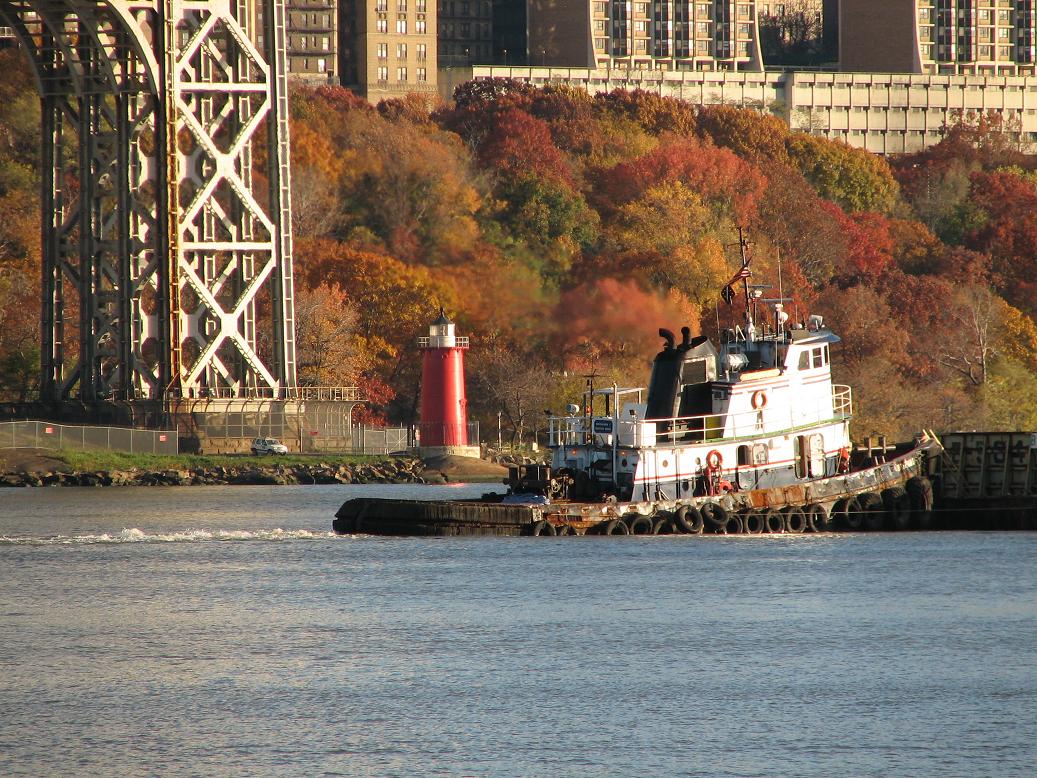

Like the City, the waters around Manhattan can be fast-paced, exhilarating, and sometimes dangerous and unforgiving, especially to newcomers.
The Hudson around Manhattan can move fast. This part of the river is nearest the sea, and surf can be a factor especially in the waters closer to the Battery. The river is narrower here than it is further upstream, and currents can be faster and trickier as well.
Of course there are the large ships. The waters abound with barges, ferries, cruise ships, the Circle Line, freighters, tankers and pleasure boats. There are so many places to dock on the waterfront here that the entire area should be considered one big shipping lane. Keep a careful watch and donít let your guard down. This is New York. Always remember the maritime rule of gross tonnage: no matter what the law-books say, always give bigger boats the right of way. And when you are in a kayak, ALL the boats are bigger than you are.
 WARNING: The City itself is not a friendly place for
kayakers for the most part. Though there are boat ramps around the City, much
of it is surrounded by seawall offering no place to land. If you are tired or
being pulled off course by wind or currents, or if a sudden storm comes up, there
is no good landing on most of Manhattan and New Jersey in this area. Seawall
also makes working the currents an adventure. Along much of the Hudson you can
work your way against a current by cruising the eddies along the shore. The shores
of the Hudson here are all developed. They are cut straight as arrows. The
natural bends and points along the shore have long since vanished. Thus,
there are no
features along the shore that produce eddies.
WARNING: The City itself is not a friendly place for
kayakers for the most part. Though there are boat ramps around the City, much
of it is surrounded by seawall offering no place to land. If you are tired or
being pulled off course by wind or currents, or if a sudden storm comes up, there
is no good landing on most of Manhattan and New Jersey in this area. Seawall
also makes working the currents an adventure. Along much of the Hudson you can
work your way against a current by cruising the eddies along the shore. The shores
of the Hudson here are all developed. They are cut straight as arrows. The
natural bends and points along the shore have long since vanished. Thus,
there are no
features along the shore that produce eddies.
Finally, there are the restricted zones. Yes, some areas around Manhattanís waterfront are forbidden to pleasure boats of any kind, mainly those around monuments like the Statue of Liberty and Ellis Island. We live in interesting times now, donít we? If you are not paying attention to the marker buoys, you may find yourself surrounded by Coast Guard vessels. If this happens, be polite, answer their questions, and above all follow their instructions to the letter or you risk arrest. You must also keep at least 500 feet away from any military vessels that you encounter along your path. Close approach to military vessels is a felony.
IF YOU ARE NEW TO THE SPORT, look into free classes and free kayak rental at the Downtown Boathouse. This is a wonderful resource that will help you to experience the best of New York's waters safely. Beginners in the New York area can also try the Ross Dock on the other side of the George Washington Bridge. The river is wider, the currents are simpler, and if you stay near the shore and head north, there are plenty of places to land if you get tired or if something unexpected happens.
If you do choose to kayak in New York, there is nothing like Manhattan. The rush of simply being there makes all the effort worthwhile. Use the camera at this link to take a look around. You will see what I mean.
PUT IN:
There are a few places in Manhattan to put in your boat.
The
Downtown Boathouse offers access to the river in several places. This
The New York City Department of Parks and Recreation also offers access from 79th Street and in upper Manhattan as well. Click here for more information. YOU WILL NEED A PERMIT TO LAUNCH.
ROUTES:
North takes you to the George Washington Bridge and the famous Little Red Lighthouse.
South takes you towards Battery Park and towards (careful, it's restricted) the Statue of Liberty.
You may cross to the Ross Dock in the north or Liberty State Park in the south.
Some kayakers circumnavigate the island of Manhattan. I don't recommend this unless you are with a group or a tour and have good equipment and lots of experience. The East River is one of two small inlets that allow the tide to flow into and out of Long Island Sound. The currents in the area aptly named Hell's Gate can be ferocious. (Sometimes as fast as three meters per second according to one source.) This is too fast for all but the most experienced.
Click for

Use of the information in this guide is at your own risk. Please read our disclaimer.
Copyright 2005 - by Jacob Tanenbaum. All rights are reserved.